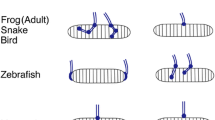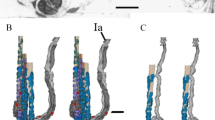Summary
Synaptic terminals of fast (FCE) and slow (SCE) excitatory neurons were physiologically identified on separate fibres of one muscle, the closer muscle in lobster claws. The innervation by these identified fibers was demonstrated over long distances (7–21 μm) by examining serial thin sections at periodic intervals. The ultrastructure of each type of innervation was consistent both qualitatively and quantitatively in two separate samples. The FCE innervation is relatively simple in having consistently small-diameter terminals each forming a single long synapse, with few synaptic vesicles, and little if any postsynaptic apparatus. The SCE innervation is more complex in having larger-diameter but more variable terminals forming several short synapses, with many synaptic vesicles and an extensive postsynaptic apparatus. These differences in the size of the synapses and the number of synaptic vesicles parallel differences in transmitter release and fatigue sensitivity characteristic of the two types of innervation. The degree of elaboration of the postsynaptic apparatus may reflect differences in the amount of transmitter taken up after release. Our data reveal for the first time in a single muscle differences between FCE and SCE innervation previously reported in different muscles and in different species.
Similar content being viewed by others
References
Atwood HL (1976) Organization and neuromuscular physiology of crustacean neuromuscular systems. Prog Neurobiol 7:291–391
Atwood HL, Jahromi SS (1978) Fast axon synapses of a crab leg muscle. J Neurobiol. 9:1–15
Atwood HL, Johnston HS (1968) Neuromuscular synapses of a crab motor axon. J Exp Zool 167:457–470
Atwood HL, Lang F, Morin WA (1972) Synaptic vesicles: Selective depletion in crayfish excitatory and inhibitory axons. Science 176:1353–1355
Atwood HL, Govind CK, Jahromi SS (1977) Excitatory synapses of blue crab gastric mill muscles. Cell Tissue Res 177:145–158
Costello WJ, Hill RH, Lang F (1981) Innervation patterns of fast and slow motoneurons during development of a lobster neuromuscular system. J Exp Biol 91:271–284
Govind CK (1979) Distribution of multiterminal innervation in a muscle fiber of the lobster, Homarus americanus. Cell Tissue Res 199:171–175
Govind CK, Chiang RG (1979) Correlation between presynaptic dense bars and transmitter output at lobster neuromuscular terminals by serial section electron microscopy. Brain Res 160:377–388
Govind CK, Lang F (1974) Neuromuscular analysis of closing in the dimorphic claws of the lobster Homarus americanus. J Exp Zool 190:281–288
Govind CK, Meiss DE (1979) Quantitative comparison of low- and high-output neuromuscular synapses from a motoneuron of the lobster (Homarus americanus). Cell Tissue Res 198:455–463
Hill RH (1981) Innervation, neuromuscular function and ultrastructure of the closer muscle in the claws of the lobster, Homarus americanus. Ph. D. Thesis. Boston University
Jahromi SS, Atwood HL (1967) Ultrastructural features of crayfish phasic and tonic muscle fibers. Can J Zool 45:601–606
Jahromi SS, Atwood HL (1974) Three-dimensional ultrastructure of the crayfish neuromuscular apparatus. J Cell Biol 63:599–613
Lang F (1975) A simple culture system for juvenile lobsters. Aquaculture 6:389–393
Mendelson T, Hoy RR, Salpeter MM (1980) Ultrastructure of neuromuscular junctions on a tonic and phasic crayfish muscle. Neuroscience Abstracts 6:179
Thomas RC, Wilson VJ (1966) Marking single neurons by staining with intracellular recording microelectrodes. Science 141:1538–1539
Tisdale D, Nakajima Y (1976) Fine structure of synaptic vesicles in two types of nerve terminals in crayfish stretch receptor organs: Influences of fixation methods. J Comp Neurol 165:369–386
Wiersma CAG (1961) The neuromuscular system. In: Waterman TH (ed) The Physiology of Crustacea. Academic Press, New York, Vol II, pp 191–240
Author information
Authors and Affiliations
Additional information
Supported by grants from NIH (NINCDS) to A.G. Humes and the late Fred Lang and from NSERC and Muscular Dystrophy Assoc. of Canada to C.K. Govind
We thank Lena Hill for her technical expertise and critical evaluation of the study, and Dr. A.G. Humes for providing research facilities
Rights and permissions
About this article
Cite this article
Hill, R.H., Govind, C.K. Comparison of fast and slow synaptic terminals in lobster muscle. Cell Tissue Res. 221, 303–310 (1981). https://doi.org/10.1007/BF00216734
Accepted:
Issue Date:
DOI: https://doi.org/10.1007/BF00216734




